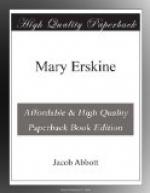“And so have been in debt for the land,” said Mary.
“Yes,” said Albert. “I could have paid off that debt by the profits of the farming. I can lay up a hundred dollars a year, certainly.”
“No,” said Mary Erskine. “I like this plan the best. We will pay as we go along. It will be a great deal better to have the three hundred dollars for something else than to pay old debts with. We will build a better house than this if we want one, one of these years, when we get the money. But I like this house very much as it is. Perhaps, however, it is only because it is my own.”
It was not altogether the idea that it was her own that made Mary Erskine like her house. The interior of it was very pleasant indeed, especially after Albert had completed the furnishing of it, and had laid the floor. It contained but one room, it is true, but that was a very spacious one. There were, in fact, two apartments enclosed by the walls and the roof, though only one of them could strictly be called a room. The other was rather a shed, or stoop, and it was entered from the front by a wide opening, like a great shed door. The entrance to the house proper was by a door opening from this stoop, so as to be sheltered from the storms in winter. There was a very large fire place made of stones in the middle of one side of the room, with a large flat stone for a hearth in front of it. This hearth stone was very smooth, and Mary Erskine kept it always very bright and clean. On one side of the fire was what they called a settle, which was a long wooden seat with a very high back. It was placed on the side of the fire toward the door, so that it answered the purpose of a screen to keep off any cold currents of air, which might come in on blustering winter nights, around the door. On the other side of the fire was a small and \ very elegant mahogany work table. This was a present to Mary Erskine from Mrs. Bell on the day of her marriage. There were drawers in this table containing sundry conveniences. The upper drawer was made to answer the purpose of a desk, and it had an inkstand in a small division in one corner. Mrs. Bell had thought of taking this inkstand out, and putting in some spools, or something else which Mary Erskine would be able to use. But Mary herself would not allow her to make such a change. She said it was true that she could not write, but that was no reason why she should not have an inkstand. So she filled the inkstand with ink, and furnished the desk completely in other respects, by putting in six sheets of paper, a pen, and several wafers. The truth was, she thought it possible that an occasion might arise some time or other, at which Albert might wish to write a letter; and if such a case should occur, it would give her great pleasure to have him write his letter at her desk.




